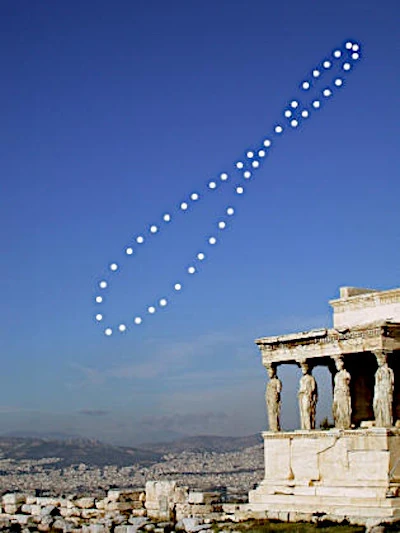
Description of the image: This analemma over Athens was created from 46 different positions of the Sun. In the foreground of this mosaic, the famous portico of the Caryatids of the Erechtheion temple, whose construction was completed in 407 BCE. Credit: 2003 in Athens (Greece) Anthony Ayiomamitis.
The Sun's analemma is an eight-shaped curve traced in the sky when the positions of the Sun at the same time each day are recorded over a full year. This figure is the result of two distinct astronomical phenomena: the obliquity of the ecliptic (the tilt of the Earth's axis of rotation) and the eccentricity of the Earth's orbit.
The obliquity of the ecliptic, or the tilt of the Earth's axis of rotation relative to its orbital plane around the Sun, is about 23.5 degrees. This tilt is responsible for seasonal variations and directly affects the Sun's altitude in the sky throughout the year. At solar noon (when the Sun is at its highest point), this tilt causes the Sun's declination to change from a maximum of +23.5 degrees at the summer solstice to a minimum of -23.5 degrees at the winter solstice.
The Earth's orbit around the Sun is not perfectly circular but slightly elliptical, with an eccentricity of about 0.0167. This means that the distance between the Earth and the Sun varies throughout the year. This variation leads to a change in the Earth's orbital speed due to Kepler's second law (law of equal areas), where the Earth moves faster at perihelion (the closest point to the Sun) and slower at aphelion (the farthest point from the Sun).
The characteristic eight shape of the analemma is a combination of the effects of the obliquity of the ecliptic and the orbital eccentricity. The two halves of the analemma are often asymmetrical due to the non-uniformity of the Earth's orbital speed:
- Effect of obliquity: The vertical component of the analemma is due to the tilt of the Earth's axis, causing the north-south movement of the Sun throughout the year.
- Effect of eccentricity: The horizontal component results from variations in the Earth's orbital speed. When the Earth is near perihelion, it moves faster, and the solar day (time between two consecutive passages of the Sun at the meridian) is slightly shorter. At aphelion, the Earth moves slower, and the solar day is longer.
Observing the analemma requires photographing the position of the Sun at the same time and from the same location every day for a year. This process highlights the seasonal and daily variations in the Sun's position.
The analemma is used to correct sundials, allowing the conversion of apparent solar time to mean solar time. Additionally, it offers a clear visualization of the combined effects of the Earth's axial tilt and orbital eccentricity on the apparent position of the Sun.
The Sun's analemma is an elegant and complex graphical representation of the dynamic interactions between the Earth's rotation, axial tilt, and elliptical orbit. Understanding the analemma deepens our knowledge of celestial movements and celestial mechanics in general. It is a striking example of the beauty and precision of the astronomical phenomena that govern our universe.